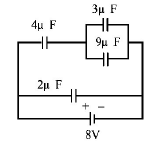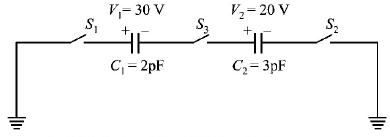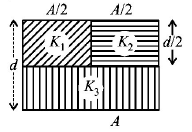Question
A combination of capacitors is set up as shown in the figure.
The magnitude of the electric field, due to a point charge $$Q$$ (having a charge equal to the sum of the charges on the 4 $$\mu F$$ and 9 $$\mu F$$ capacitors), at a point distance $$30m$$ from it, would equal :
A combination of capacitors is set up as shown in the figure.
The magnitude of the electric field, due to a point charge $$Q$$ (having a charge equal to the sum of the charges on the 4 $$\mu F$$ and 9 $$\mu F$$ capacitors), at a point distance $$30m$$ from it, would equal :

A.
$$420\,N/C$$
B.
$$480\,N/C$$
C.
$$240\,N/C$$
D.
$$360\,N/C$$
Answer :
$$420\,N/C$$
Solution :

Charge on $${C_1}$$ is $${q_1} = \left[ {\left( {\frac{{12}}{{4 + 12}}} \right) \times 8} \right] \times 4 = 24\mu c$$
The voltage across $${C_p}$$ is $${V_P} = \frac{4}{{4 + 12}} \times 8 = 2v$$
$$\therefore $$ Voltage across $$9\mu F$$ is also $$2V$$
$$\therefore $$ Charge on $$9\mu F$$ capacitor $$ = 9 \times 2 = 18\mu C$$
$$\therefore $$ Total charge on $$4\mu F$$ and $$9\mu F = 42\mu c$$
$$\therefore E = \frac{{KQ}}{{{r^2}}} = 9 \times {10^9} \times \frac{{42 \times {{10}^{ - 6}}}}{{30 \times 30}} = 420\,N{c^{ - 1}}$$

Charge on $${C_1}$$ is $${q_1} = \left[ {\left( {\frac{{12}}{{4 + 12}}} \right) \times 8} \right] \times 4 = 24\mu c$$
The voltage across $${C_p}$$ is $${V_P} = \frac{4}{{4 + 12}} \times 8 = 2v$$
$$\therefore $$ Voltage across $$9\mu F$$ is also $$2V$$
$$\therefore $$ Charge on $$9\mu F$$ capacitor $$ = 9 \times 2 = 18\mu C$$
$$\therefore $$ Total charge on $$4\mu F$$ and $$9\mu F = 42\mu c$$
$$\therefore E = \frac{{KQ}}{{{r^2}}} = 9 \times {10^9} \times \frac{{42 \times {{10}^{ - 6}}}}{{30 \times 30}} = 420\,N{c^{ - 1}}$$

